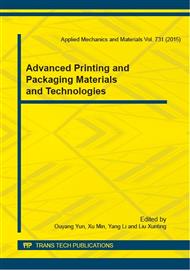p.231
p.237
p.242
p.248
p.255
p.260
p.265
p.269
p.273
Application on Gravure Plate-Making Method in Printing Transparent Conductive Film
Abstract:
The transparent conductive film (TCF) is the conductive material with higher light transmittance and good conductivity in the visible light range. Up to now, it is popular to print transparent conductive film with metal grid. From the perspective of making transparent conductive film by gravure printing, the printing effect of the fine lines on the TCF is analyzed by diverse gravure plate-making method. According to the requirements of the fine lines and conductivity for TCF, the two kinds of plate are made respectively by laser ablation method and laser engraving method, and applied respectively in proofing. The advantages and disadvantages of the two plate-making methods are evaluated, according to the analysis on the line width, conductivity and light transmittance of the TCF. The research results show that the laser ablation method can obtain the good electric conductivity and light transmittance of the TCF, but a relatively larger printing line width, the laser engraving method can get better relatively small line width, but the poor conductivity and light transmittance. So, the plate-making process needs to be improved.
Info:
Periodical:
Pages:
255-259
Citation:
Online since:
January 2015
Authors:
Price:
Сopyright:
© 2015 Trans Tech Publications Ltd. All Rights Reserved
Share:
Citation:


